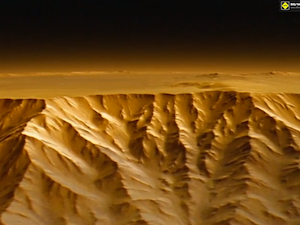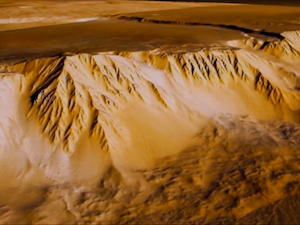Solving the Mystery of Dendritic Ridges
The Thunderbolts ProjectTM is proud to announce its first Innovative Experiment PrizeTM : dendritic ridge systems created by electric discharge. Three cash prizes will be awarded: Gold-$6000; Silver-$3000; and Bronze-$1000.
In the planetary science of the Electric Universe, the priority must be on experimental verification. For The Thunderbolts ProjectTM, dendritic ridge formation by electric discharge tops the present scientific agenda. We believe it’s time for a definitive experiment to test the electrical interpretation.
Background

Dendritic ridges along Valles Marineris on Mars. Credit: NASA/Google Mars
Dendritic ridges stand out emphatically across the surface of the planet Mars. These sharply sculpted ridge formations occur on surface features said to have been created by vastly different geologic processes. They can be seen along the great chasm of Valles Marineris, on both the scarp and the “caldera” walls of Olympus Mons, along the cliffs of towering mesas, on the great blocks of the “fractured terrain” of Noctis Labyrinthus, extending down the walls of winding channels or rilles, and even on the margins of giant craters.
Always the tree-like patterns point down from the summits of the cliffs. But why do they consistently appear between the distinctive scallops carved along the cliff walls?
No formative process in the lexicon of planetary science can produce these distinctive features. But raised “Lichtenberg” formations (dendritic ridges) can be produced electrically. Therefore, an electrical interpretation of the Martian features is eminently suited for experimental verification.
In a former phase of solar system evolution, was the planet Mars immersed in electric discharge? If an electrical experiment can answer a question left unanswered by billion-dollar space programs, the results will mean more than just a good theory. One compelling experiment could change not only our understanding of the Martian past but our understanding of Earth history as well. The implications would not stop there.
Dendritic Ridges–An Electrical Interpretation
In 1777, Georg Christoph Lichtenberg demonstrated the lightning-like dendritic patterns taken by dust on non-conductive surfaces subjected to electric sparks. In honor of his contribution, these electrical patterns came to be named “Lichtenberg Figures.”
Lichtenberg experimented with variations in the observable effects of electric sparks to surfaces of different characteristics, including positively and negatively charged materials. Thanks to him and his successors, it is now known that dusty surfaces can display the effects of gaseous electrical discharge streamers or leaders along insulating materials, also called dielectrics. Read More>>>>
Caveats and Complementary Notes
Dendritic or “tree-like” patterns typical of lightning and electric discharge are common throughout the natural world. Many of these are poorly understood. The most fully acknowledged instance geographically is the branching ravine pattern of fluid erosion. But the subject of the Dendritic Ridge Experiment displays the opposite characteristic: material gathered into sharply sculpted, elevated terrain. Read more>>>
The Dendritic Ridge Experiment
CAUTION: Working with electric discharge experiments requires both knowledge and systematic precautions. No greater mistake could be made than to take up such work without proper knowledge and training.

Dendritic ridges along the scarp of Olympus Mons. Credit: NASA/Google Mars
The intent of the experiment is to produce a compelling demonstration of dendritic ridge systems similar to formations appearing on the planet Mars. Lichtenberg’s work needs to be more directly applied to planetary surfaces. Dendritic ridges on Mars will serve as the model to be replicated. Think three-dimensionally of the surface configuration that, in the course of the experiment, could maximize the match to the Martian prototype.
Entries will be judged in order of priority:
- Quality of the experiment itself — 50%;
- Quality of video and/or photographic record — 20%:
- Quality of experimental description — 15%;
- Quality of written interpretation — 15%.
Submitting the Experiment
Details
- Applications will be accepted beginning November 15, 2013.
- Deadline for submissions will be February 15, 2014 at 11:59 pm.
- Any submissions received after that date and time will not be considered.
- Finalists will be announced by March 15, 2014, on this Webpage.
- All prize decisions are final and not subject to appeal.
- The judges may award none, one, two or three prizes based on the quality and number of the submissions.
- Announcement of the Innovative Experiment PrizeTM will be made at the EU2014 Sunday Night Banquet, March 23, 2014, Marriott Pyramid North, Albuquerque, New Mexico, USA.
Personal Information
- Applicants must be 18 years of age or older.
- Each application should include the experimenter’s full name, date of birth, current address including country, email address and phone number.
Agreements
- All applicants give permission for promotional or other uses of submitted content when they submit their experiment documents. It is understood that experimental designs will be made public on a schedule determined by The Thunderbolts ProjectTM.
- Any unique intellectual property generated will be owned by the prize applicant, who nonetheless agrees that the experimental designs will be made public as noted above.
- Accuracy in all information provided is expected. False information will be grounds for disqualification.
Submission
- Applicants will choose the style and content of their submissions.
- Submission and/or questions should be sent to susan@thunderbolts.info.

A small section of the 3,000 mile trench, Valles Marineris. The chasm exhibits dendritic ridges along its entire length. Credit: NASA/Google Mars

Full-length view of Valles Marineris. Credit: NASA/Google Mars












